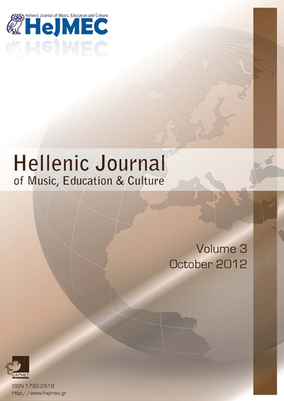Integrating the Arts: Educational Entrepreneurship in a School Setting
Part of : Hellenic journal of music, education and culture ; Vol.2, No.1, 2011, pages 5-17
Issue:
Pages:
5-17
Author:
Abstract:
What qualities make for successful integration of the arts and the so-called corecurriculum? Clearly, integration requires more than scheduling changes, and results in substantiallearning well beyond drawing snowflakes in science or singing patriotic songs in social studies. Thispaper presents one case of arts integration in a Texan high school, where the project coordinatorwas the music teacher. I examine those qualities that made it a successful integration, including thecurriculum, the institutional structures, and some of the characteristics and background of theproject coordinator. Based on this and other cases of successful integration of the arts into theacademic curriculum (and as important, cases where such integration failed despite seeminglypromising conditions), I identify some characteristics that are important to arts integration. Thesecharacteristics include: (i) going beyond the traditional disciplinary knowledge to creatively reflectownership and personal commitments; (ii) being able to listen to others and to collaborate in what Irefer to as transformative practice zone (TZP); and (iii) perseverance in a process of experientiallearning of the innovation. These characteristics, I suggest, constitute educational entrepreneurship,with an emphasis on the social and the intellectual.
Subject:
Subject (LC):
Keywords:
Arts, integration, curriculum, Educational Entrepreneurship, Context of Schooling
References (1):
- Bresler, L. (1997a). General issues across sites: The role of the arts in unifying high school curriculum. A reportfor the College Board/Getty Center for the Arts.Bresler, L. (1997b). Arts integration in the Texas site. A report for the College Board/Getty Center for the Arts.Bresler, L. (2003). Out of the trenches: The joys (and risks) of cross-disciplinary collaborations. Council ofResearch in Music Education, 152, 17-39.Bresler, L. (2005). What musicianship can teach educational research. Music Education Research, 7(2), 169-183.Bresler, L. (2006). Embodied Narrative Inquiry: A Methodology of Connection. Research Studies in MusicEducation, 27, 21-43.Bresler, L. (2008a). The Music Lesson. In J. G. Knowles, & A. Cole (Eds.), Handbook of thewArts in Qualitative Inquiry: Perspectives, Methodologies, Examples, and Issues (pp. 225-237). Thousand Oaks,CA: Sage.Bresler, L. (2008b). Research as experience and experience as research: Mutual shaping in the arts and inqualitative inquiry. LEARNing Landscapes, 1(3), 123-132.Bresler, L, Wasser, J., Hertzog N., & Lemons ,M. (1996). Beyond the lone rangerresearcher: Teamwork in qualitative research. Research Studies in Music Education, 7, 15-30.Cannon, M. D., & Edmondson, A. C. (2005). Failing to learn and learning to fail (intelligently): How greatorganizations put failure to work and innovate and improve. Long Range Planning, 38, 299-319.Cardon, M. S., & McGrath, R. G. (1999). When the going gets tough: Towards psychology of entrepreneurialfailure and re-motivation. In P. Reynolds et al (Ed.), Frontiers of Entrepreneurship Research (pp. 58-72).Wellesley, MA: Babson College.Esquith, R. (2004) There Are No Shortcuts. London: Penguin.Kolb, D. A. (1984). Experiential learning: experience as the source of learning and development. EnglewoodCliffs, NJ: Prentice Hall.Lincoln, Y. S., & Guba, E. G. (1985). Naturalistic inquiry. Newbury Park, CA: Sage.McGrath, R., G. (1999). Falling forward: Real options reasoning and entrepreneurial failure. Academy ofManagement Review, 24(1), 13-20.Palmer, P. (1998). The courage to teach: Exploring the inner landscape of a teacher's life. San Francisco:Jossey-Bass Productions.Petroski, H. (1992). To Engineer is human: The role of failure in successful design. New York: Vintage Books.Petroski, H. (1996). Invention by design: How engineers get from thought to thing. Cambridge: HarvardUniversity Press.Politis, D., & Gabrielsson, J. (2007). Entrepreneurs' attitudes towards failures -- An experiential learningapproach. Babson College Entrepreneurship Research Conference (BCERC 2007). Retrieved fromhttp://ssrn.com/abstract=1064982 on January 25, 2008.Schon, D. A. (1983). The Reflective practitioner: How professionals think in action. New York: Basic Books.Solomon, J. L., Marshal, P., & Gardner, H. (2005). Crossing boundaries to generative wisdom: An analysis ofprofessional work. In R. Sternberg & J. Jordan (Eds.), A Handbook of Wisdom (pp. 272-296). New York:Cambridge University Press.Spinosa, C., Flores, F., & Dreyfus, H. (1997). Entrepreneurship, democratic action, and the cultivation ofsolidarity: Disclosing new worlds. Cambridge: MIT Press.Thornhill, S., & Amit, R. (2003). Learning about failure: Bankruptcy, firm age and the resource-based view.Organizational Science, 14(5), 497-509.Vesper, K. H. (1980). New venture strategies. Englewood Cliffs, NJ: Prentice-Hall.Wee, S. (2009). Drama education curriculum by drama specialist in early childhood education.Unpublished dissertation. University of Illinois, Urbana-Champaign.Wee, S. (in press). Dramas of Collaboration between a Drama Specialist and Early ChildhoodClassroom Teachers. Early Childhood Education Journal.




